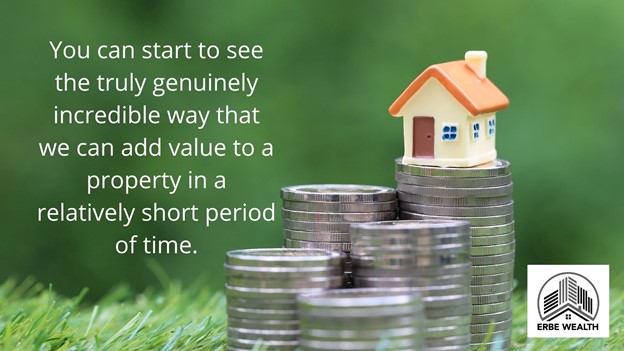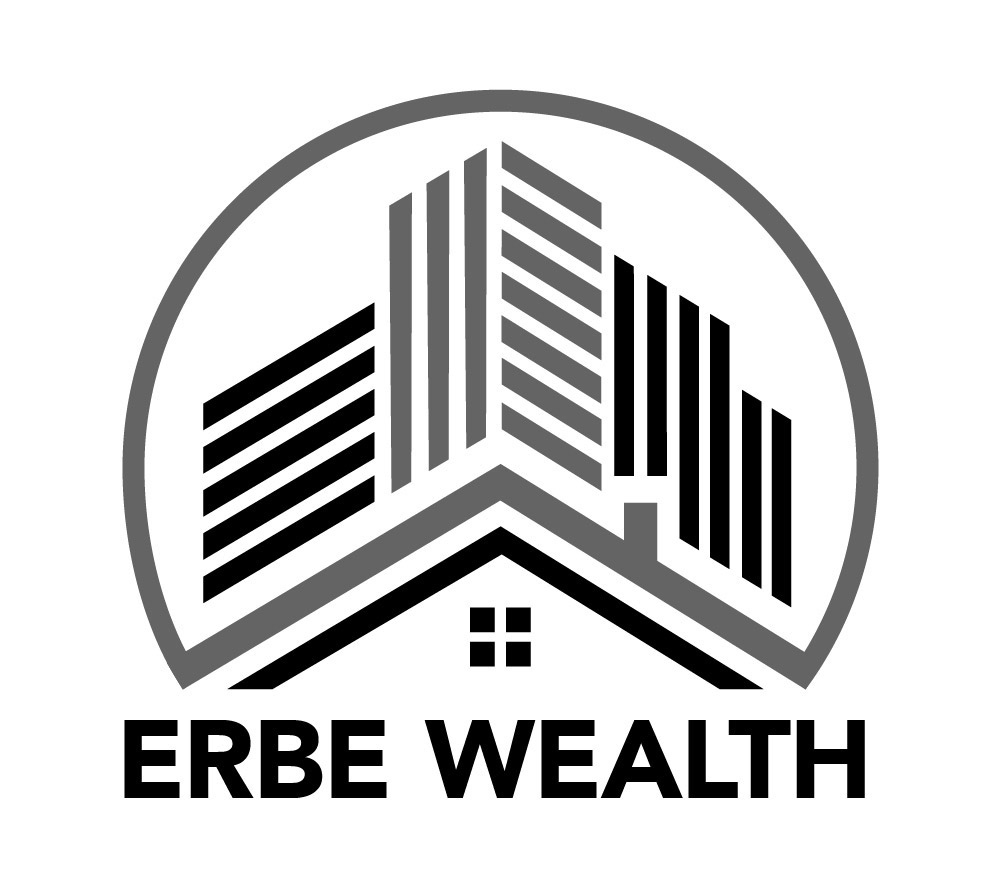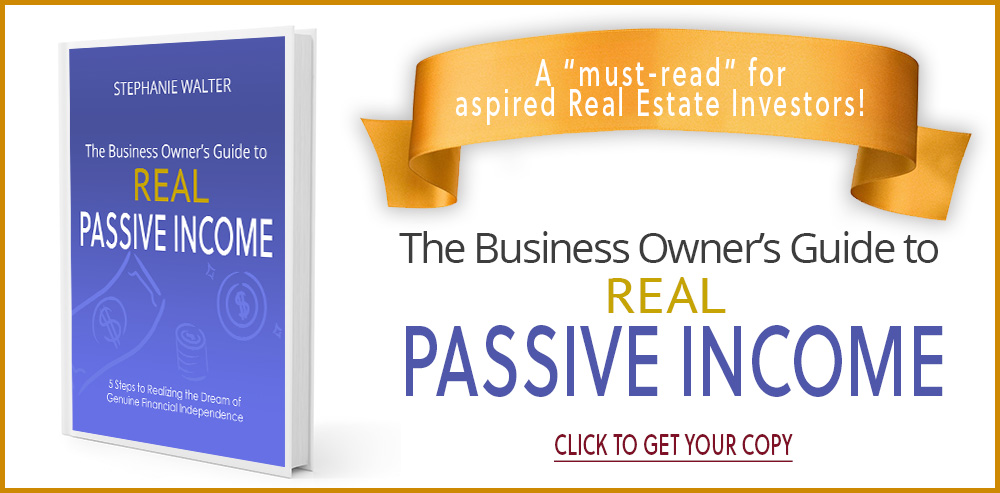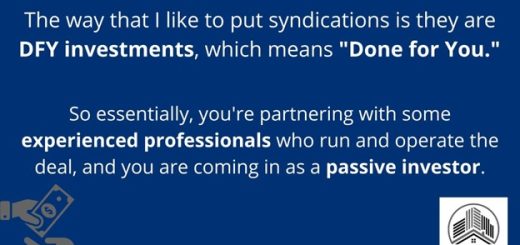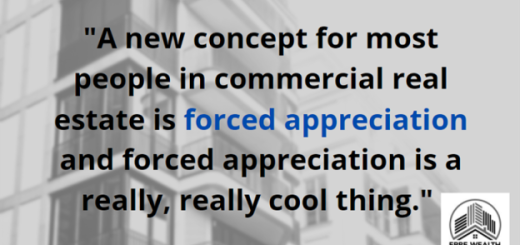Commercial Value
by Erbe Wealth · Published · Updated
How is Commercial Real Estate is Valued?
When I talk to my investors and prospective investors, I’m always surprised at how confused people get about this concept.
The question that usually comes my way is: “What if I buy into this multifamily residential apartment community you have and there’s a huge recession, similar to what happened in 07, 08, and 09. What would that do to the multifamily property that I’m investing in?”
That’s when I need to step in and explain that there is a fundamental difference between commercial multifamily values and residential rentals. For example, let’s look at a person who owned a rental property during that terrible time in 2007, 2008, and 2009. What happened then was people couldn’t continue paying their mortgages, so they left their houses. The number of vacant houses increased until there were so many on the market that the values of the homes went down. Why?
Let’s say a person down the street wants to look at the value of their house. They would determine the value of their home by pulling up comparable properties nearby them with the same features, year, square footage, and everything like that. That tells them what their house is worth.
When the economy crashed in 2007-2009, there were a bunch of houses that were vacant and had to be sold for a meager amount. That negatively affected the residential home values and people that lived right down the street.
The beautiful thing about commercial real estate is that the value of an apartment complex is based on the income that it provides. That’s a real learning point for people investing in commercial real estate for the first time. I tell people to think of an apartment complex as a business because that’s what it is. The value of this business is based on the income that it brings in, minus the expenses, which equals the net operating income (NOI).

From that, we determine the property’s value in that particular market. The cool thing about valuing a property in that way is that we try to buy properties that are considered off-market or pocket listings. These are properties that don’t go to the market through a commercial real estate broker.
We target a seller who’s just tired of being a landlord like a mom-and-pop type of operation. They maybe have been running their property for a really long time and could be burned out and ready to ready to move on to something else.
That scenario gives us a huge opportunity, so that’s exactly what we look for when purchasing a property. We call this a value-add property because we can easily bring value into the property to dramatically increase the NOI. The NOI can increase by either increasing the income coming in or decreasing the expenses.
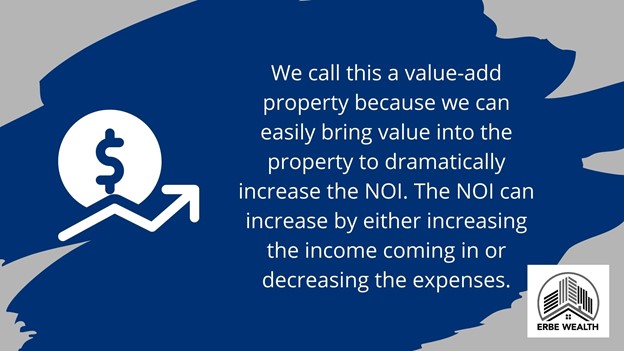
This is really easy for us because we bring in our well-experienced team of professionals who can do the things needed in a few months to get the property running as efficiently as possible. I know this because we have done it time and again.
Appreciation
A cool benefit of commercial real estate is that it can appreciate in two different ways. The first way is natural appreciation which is basically what most people would think of when thinking about appreciation.
Natural appreciation would include buying in a good area where you know the home values will go up over time. That’s something we do when purchasing commercial real estate. We do this very methodically to ensure we are investing in a growing or emerging market. Please see my article How We Find the Best Markets to Invest In to learn more.
The much more substantial way of bringing value to a property is the second way: forced appreciation. All that means is that we’re going to take the property and raise the rents to market price. Many of these single operators we are purchasing from are just happy to have tenants and don’t raise the rents at all (maybe for years at a time), so the units might be 50, 100, or 200 dollars a month under market rents for the area. In addition, these non-savvy landlords are not charging standard fees. For example, pet fees, parking fees, or storage fees. Many times, the landlords are not charging for water or electricity, so we start charging for these services. These are services, quite frankly, that the tenants should have been paying for all along. There are many opportunities to increase income by just doing these simple things. With every dollar that we can increase the net operating income, we can force the appreciation of the property, which means we can make the property’s value go up quite significantly in a short period.
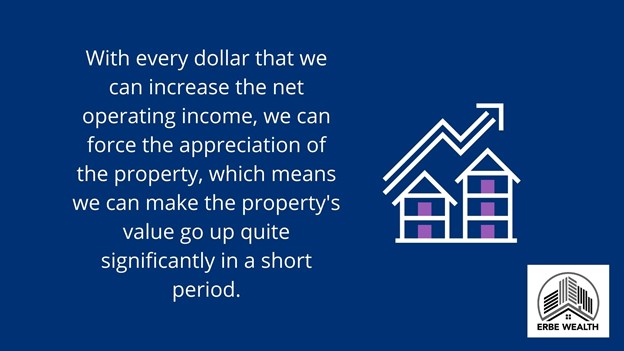
What are some different ways our team decreases expenses? Again, looking at the types of buyers we typically purchase from, they have owned the property for a long time and have just let some things go. That means there are usually numerous ways to streamline the property and cut some overpriced expenses.
The most common example we see is they have had the same contractors (i.e. landscaper, maintenance person, property management company) for years, and their prices have gone up and up and up.
When we take over a property, we look to streamline the process. We go into markets and buy in areas where we have a few properties to begin with. We have established relationships with those local contractors already. They are already working at our other properties and tend to like to continue to work with us since we have so much business to give them as opposed to a single property. Next, we use in-house property managers. They are our employees and are well experienced in implementing our business plan for the property.
Our business plan tends to be almost identical in each of the value-add properties we purchase, so we have it down to a science, and it is a lot easier than most people think.
Specifically, we buy in areas where we’ve done a great deal of due diligence to know when there is a lack of housing. Right off the bat, there is demand for our product. Then the first steps are increasing the rent to market, billing for utilities, and charging the tenants for applicable fees.
The next step happens when a unit turns, meaning the tenant moves out. We go into the unit and complete micro renovations. For us, that means things like pulling up the flooring, replacing flooring, updating the kitchen with new appliances and stone countertops, putting in new lighting fixtures, and doing some accent painting on the walls. Overall, they are all pretty minor things, and there is no heavy lifting. From there, we raise the rent to what market rents would be for an updated unit and get a new tenant in.
An Example Appreciation
I’ll walk you through a simple example of how doing these things can add significant value to our properties. Let’s talk about a 100-unit property. When we acquire this apartment complex, we know that we can raise the rent fifty dollars a month on each unit. That’s something that we implement, so when all is said and done, that rental increase adds an extra five thousand dollars of income a month. We multiply that by 12 months in the year, and that’s sixty thousand more dollars a year.
To determine the value that adds to the property, we take the sixty thousand, and we divide it by the cap rate. You are probably wondering what a cap rate is, so I’ll give you a simple definition for our purposes. If you want a more detailed explanation, please check out my article MF Syndications explained: Cap Rate.
We will keep it simple: cap rate is short for capitalization rates, and it’s a measure used to estimate and compare the rates of return on multiple commercial real estate properties. Cap rates are calculated by dividing the property’s net operating income by the property’s asset value.
In a nutshell, it’s a way of comparing properties that are in the same area. It is a very simple calculation to make.
So in our example, we will take the increased income and divide it by a cap rate. I’m going to use a five percent cap rate, so we will just pretend that’s what properties in the area are trading for.
That increases the value of the property to $1,200,000.00. And no, you did not miss something. That’s one increase of rent that has added a value of $1.2 million to the property.
That is just astounding because that is only one rental increase, but as you have learned by reading this article, there are so many other things we do to increase income. You can start to see the genuinely incredible way that we can add value to a property in a relatively short period. That is the bottom line of why our investors and we love value-add real estate projects.
